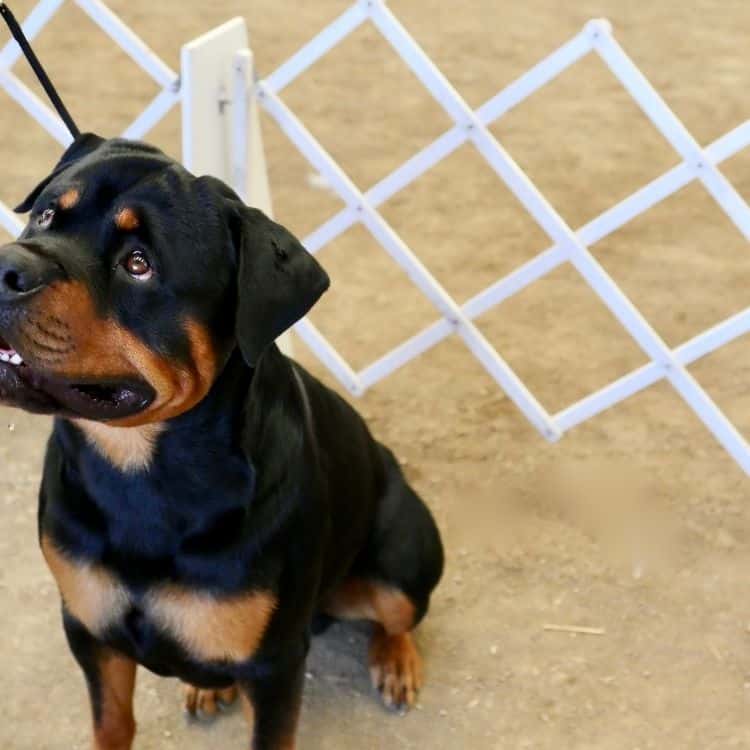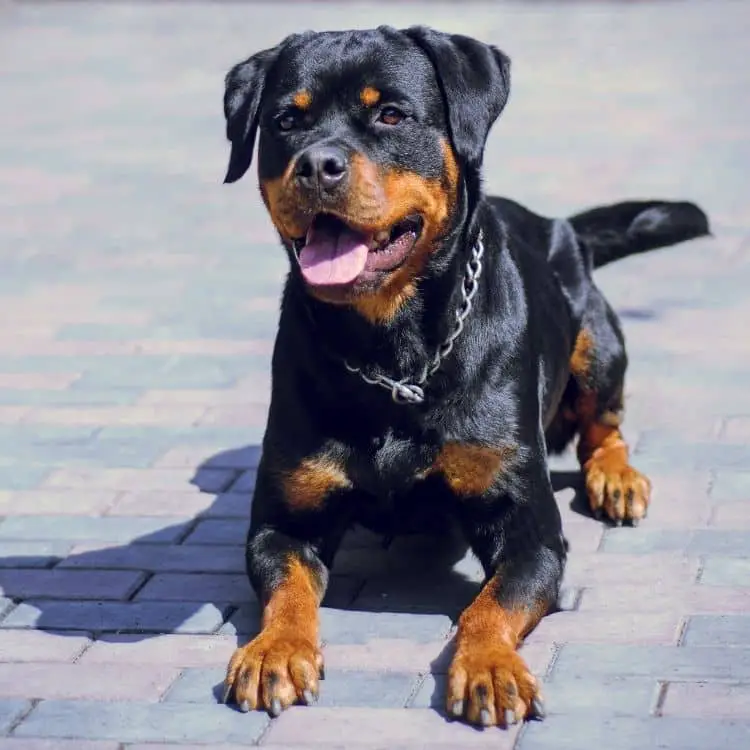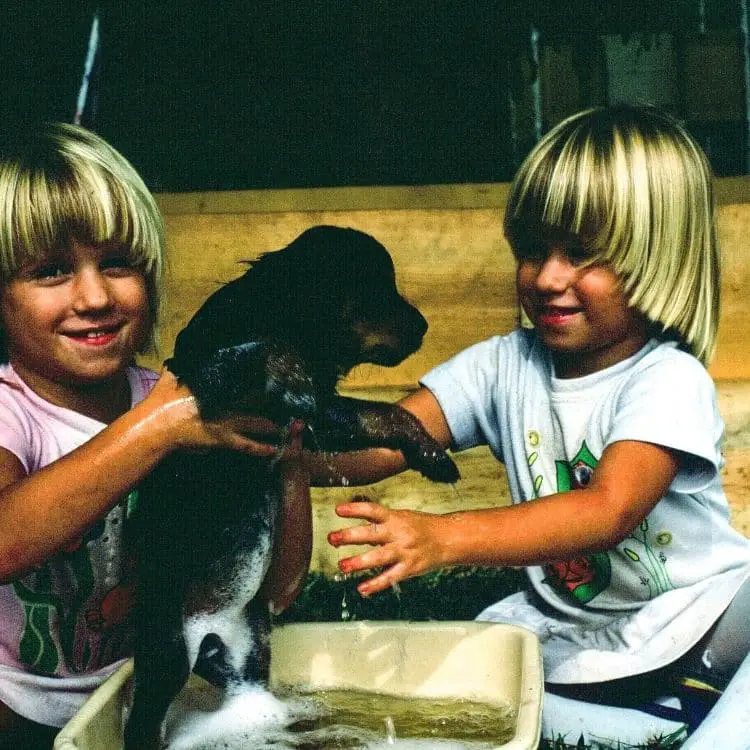Getting a Rottweiler is fun but not so easy to take care of, especially when you plan to have him at home. But do rottweilers shed?
There are several factors owners consider before bringing a dog home, and one of most important factors is shedding.
Some of us wrongly assume that short hair rottweilers don’t shed and can easily keep the house clean from their fur. However, this is not entirely true.
Do Rottweilers Shed?

Yes, rottweilers do shed. Actually, they shed the same amount of fur as long-coated breeds, as they have a double-layer coat.
In general, the Rottweiler is considered a medium to high shedding breed, with less shedding throughout the year but more shedding in the spring and fall.
The Rotties shed an average amount of soft fur during most of the year, but this increases and becomes very noticeable during the shedding season.
Shedding is completely normal and healthy, especially in the undercoat of Rotties. However, if you have allergies to dog fur or can’t stand it flying around the house, I recommend getting an alternative breed. [1]
Rottweiler Coat Characteristics
To understand Rottweiler’s shedding better, let’s first discuss their coat and its characteristics.
Rottweilers’ origin comes from the extremely cold regions of Germany, where they developed a coat that keeps them warm even in the harshest conditions.
The Rottweiler’s shaggy coat is entirely covered by a soft, dense, lighter-colored undercoat and a smooth, firm outer coat.
The Rottweiler’s facial hair is medium length and shorter on the head, ears, and legs, and the undercoat is mainly on the neck and thighs.
The amount of undercoat on a Rottie depends on its climate. Usually, their undercoat is thicker in winter but light in summer.
Rottweilers are always black ranging from rust to mahogany. These marks appear above the eyes, on the cheeks, on the sides of the nose, on the legs, chest, and below the tail. There are also brown lines on the toes that resemble pencil marks.[2]
Why Rottweilers Shed?

Now that you understand your Rottweiler’s coat, let’s discuss in detail why your Rottie sheds.
The cause of Rottweiler shedding is relatively common for dual-coat breeds: the undercoat is a soft layer, which loosens and comes off and causes all of these problems.
The undercoat fur works as insulation. It protects the Rottweiler from sunburn and makes it easier for the dog to stay outside in cold weather.
Meanwhile, the topcoat is what we see, and it’s sturdier and more protected against all external elements like rain and wind. So when you see your Rottweiler shedding, that’s the undercoat coming off because the coat has completed its life cycle.
Thus, shedding in Rottweilers is part of the natural hair growth cycle in which hair grows, stops growing, and eventually falls out to be replaced by new hair.
Some breeds tend to have a faster hair growth cycle, which means more fur in the house, so Rottweiler shedding might be considered acceptable, compared to Huskies, for example.
To break it down a little bit more specifically, the cycle of your Rotties’ shedding consists of several phases: the anagen, catagen, telogen, and exogen phases.
Rotties tend to strip off their winter coats in the spring as they no longer need thicker winter coats for the upcoming summer months. The same is true in the fall when they shed their summer coats and grow into thicker winter coats.
Brushing should become a daily activity during shedding season to avoid dropping your dog’s fur throughout the house. Typically, this severe hair loss season lasts about three weeks. [3]
How Bad Do Rottweilers Shed?
Generally, the only time Rottweiler shedding is really bad is during seasonal shedding, as this is just one way the dog adapts to the changing seasons.
However, if you notice excessive shedding as a long-term problem and have concerns, it may be best to discuss it with a veterinarian.
Why Do Rottweilers Shed So Much?
First of all, the main reason why your Rottweiler is shedding so much is that you keep him as an inside pet.
Over history, these gorgeous, delicate, and stubborn dogs have never spent as much time on the sofa as they do today, so shedding hasnever been as severe a problem for previous Rottweiler owners as it might become for modern ones.
However, they do get adjusted, and shedding should be reduced after your Rottweiler adapts to the room temperature. If that’s not so, and you still notice excessive shedding in your Rottweiler puppy, then it is must be due to anxiety, fleas, allergies, poor diet, hormone levels, or a medical condition. [4]
Anxiety
Extra shedding is a common symptom when feeling anxious in many dogs, including Rottweilers.
Even though powerful Rottweilers are not naturally anxiety-prone dogs, they sometimes take many aspects of life seriously and sensitively.
Your Rottweiler may be stressed about having new people or animals around, triggering his vigilance instinct and creating confusion about how he should behave. While most dogs are stressed, your Rottweiler may also be stressed, such as at a veterinarian or groomer.
Rottweilers tend to have anxiety when they feel fear. If you notice excessive panting, wide-eyed, and mute expressions, then fear is more likely to be the cause of your Rottweiler’s shedding.
Fleas
If your Rottweiler is suddenly shedding more than usual, especially during the summer months when pests are more common, and if he is not receiving flea prevention treatment, fleas may be the cause of your Rottweiler’s shedding. Fleas can irritate a dog’s skin, causing them to scratch more and cause hair loss.
Many dogs are allergic to flea bites, making the reaction worse. If you notice small black spots, especially on your dog’s back and bottom of the tail, or if you see fleas, they are most likely the cause of the skin issue and shedding in your Rottweiler. [5]
Allergies
Moreover, Rottweilers may be allergic to the environment or diet. Allergies themselves don’t usually cause shedding, but they can cause itchy and dry skin, which can cause your dog to scratch and increase hair loss.
Allergies are often associated with seasonal spring shedding, making it difficult to pinpoint the exact cause of your Rottweiler’s massive shedding. If you notice not only hair loss but also signs of dry skin marks, and if your Rottie is frequently scratching or starts growling when you try to touch the area, it may be due to allergies.
The Wrong Diet
A poor diet or some human food can lead to food allergies, which will cause shedding at some point. Not providing your dog the proper nutrients to maintain a lush coat can definitely cause the issue.
If you notice that your Rottweiler starts to lose more after changing his diet, you may consider switching to higher quality food. Look for foods containing soothing grains, like oatmeal, and oils that help your dog’s coat, like fish oil and flaxseed oil.
Additionally, Rottweilers need to eat a high-protein diet and get plenty of micronutrients. Omega-6 fatty acids can also help improve the overall health of the coat, thereby reducing shedding.
Dehydration
In most cases, dehydrated skin becomes a major cause of excessive shedding and can increase the amount of loose fur you need to clean at home. Rottweilers weigh approximately 40kg, so, on cool days, they should drink about 2 liters of water per day.
On hotter days, you should increase their water intake by 50% to three or four liters of water in summer. Hydronation has a major influence on your dog’s overall health and fur, so don’t forget to take care of it.
Overwashing
Increased washing of Rottweiler or using harsh shampoo can also cause your dog to shed more than usual.
Rottweilers are born with a slightly greasy waterproof coat. Removing this oil from the coat more often than necessary can cause the fur to dry out and shed more than usual.
Also, never try to wash your Rottweiler with human shampoo. Instead, use a PH balanced shampoo, specifically formulated for your dog skin type.
Ideally, it is recommended to wash your Rottweiler every three to four weeks or when he gets dirty. [6]
Hormones
Hormonal disbalance also often becomes the reason for excessive shedding in Rottweilers. Some dogs shed more after pregnancy or childbirth. Excessive shedding can also be a reaction to spaying or neutering your dog.
You may find that your female dog sheds more hair as she goes through a period or when the male smells the female dog in heat.
Infection
If you notice shedding patches on the coat, your Rottweiler may have a skin infection.
Bacterial skin infections, ringworm, fungal infections, etc., can all cause uneven hair loss.
Your dog may shed more all over the body and have bald or thin patches in certain areas, which he would scratch intensively.
Inflammatory Bowel Disease
Rottweilers are particularly prone to inflammatory bowel disease compared to some other breeds. IBS can cause symptoms similar to humans in dogs, such as diarrhea, indigestion, vomiting, and bloating.
However, IBS can cause signs in dogs that are not necessarily obvious in humans, such as lousy coats or shedding. Similar to malnutrition, IBS means your Rottweiler is not getting all the nutrients he needs, which can cause his coat to fall excessively.
There is no medicine to cure IBS, but it can be managed and controlled within the proper lifestyle and dietary choices. So if you think IBS is the reason for shedding, talk to your veterinarian about how to help your Rottie.
How To Stop Your Rottweiler From Shedding
Honestly, because of the way nature has built Rottweiler coats, they will permanently shed some fur. Maintain the correct diet, monitor every increased scratching, check for allergies, and you will avoid extra shedding of your Rottweiler.
Correct bathing and brushing frequencies are also the essential components of rottweiler skin care, and you will still manage to minimize the shedding.
How And Why Should You Brush Your Rottie Regularly?
Regular brushing significantly reduces shedding. Shed your Rottweiler with a soft brush about once a week for most of the year. However, during Rottweiler season, when they start to blow off the loose hair, you should increase the frequency of brushing. In some cases, daily brushing may be best to keep up with hair loss.
Brushing helps remove any loose hair and can make a difference, especially in undercoats where hair can gather and get stuck. I strongly recommend brushing your Rottweiler outside to avoid dropping those loose hairs in your house. Your Rottweiler may also enjoy the time spent outdoors and a good brushing experience!
How To Wash And Groom A Rottweiler

Dogs tend to love water more than cats, but not all of them are fans, as it’s mainly dependent on their personal character. Thus, if you want to keep your Rottie brushed and bathed to reduce shedding, you might be seeking some grooming tips and tools.
Rottweilers are among the killer dogs’ list, so forcing an adult and stubborn Rottie to enter the shower against their will might be risky. Even though they have short fur and don’t require often showering, I recommend getting your Rottie used to water from young age. Make it a fun experience, including treats, toys, praises.
Always brush your Rottweiler before bathing and apply high-quality dog shampoo. In the end, if you blow-dry your Rottie, make sure you cover his ears, as he might get scared and accidentally end up biting you.
Read Also: Do Corgies Shed
Wrapping up
In conclusion, yes, Rottweilers do shed. Most Rottweiler owners are not even aware of their dual-coat and shedding specifics before they actually get one. However, never think of shaving as a solution to shedding, as it will only hide the issue from your sight for a few weeks but will definitely come back to you more severely.
So, to avoid any inconvenience, consulate with the vet, learn about the Rottweiler coat in advance, and welcome your new pup prepared at home!
Read Next: Do Bernese Moutain Dog Shed
